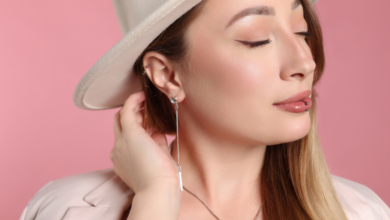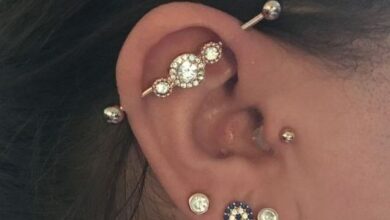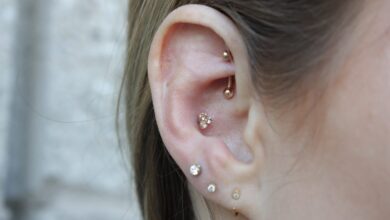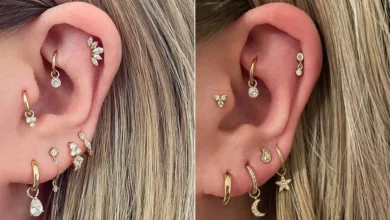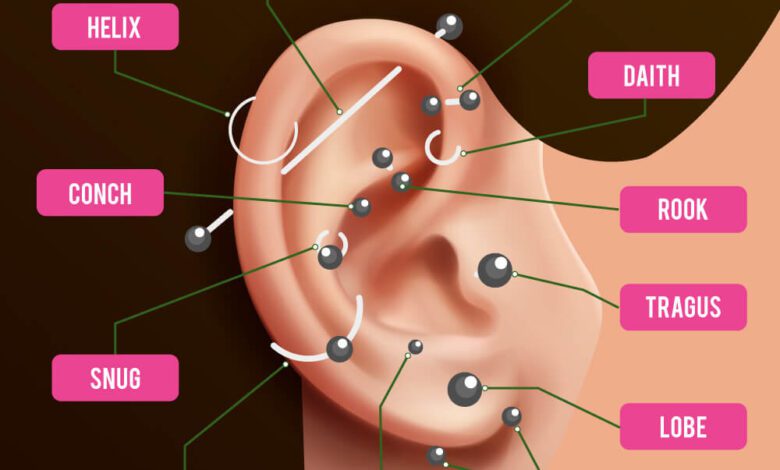
Are you a fan of ear piercings, but find yourself confused by all the different names? Look no further! In this article, we will decode the names of some popular ear piercings, including Tragus, Rook, and Helix. By the end, you’ll have a clearer understanding of these trendy piercing styles, making it easier for you to choose the perfect one for yourself! Let’s dive in and uncover the secrets behind these unique and stylish ear piercings.
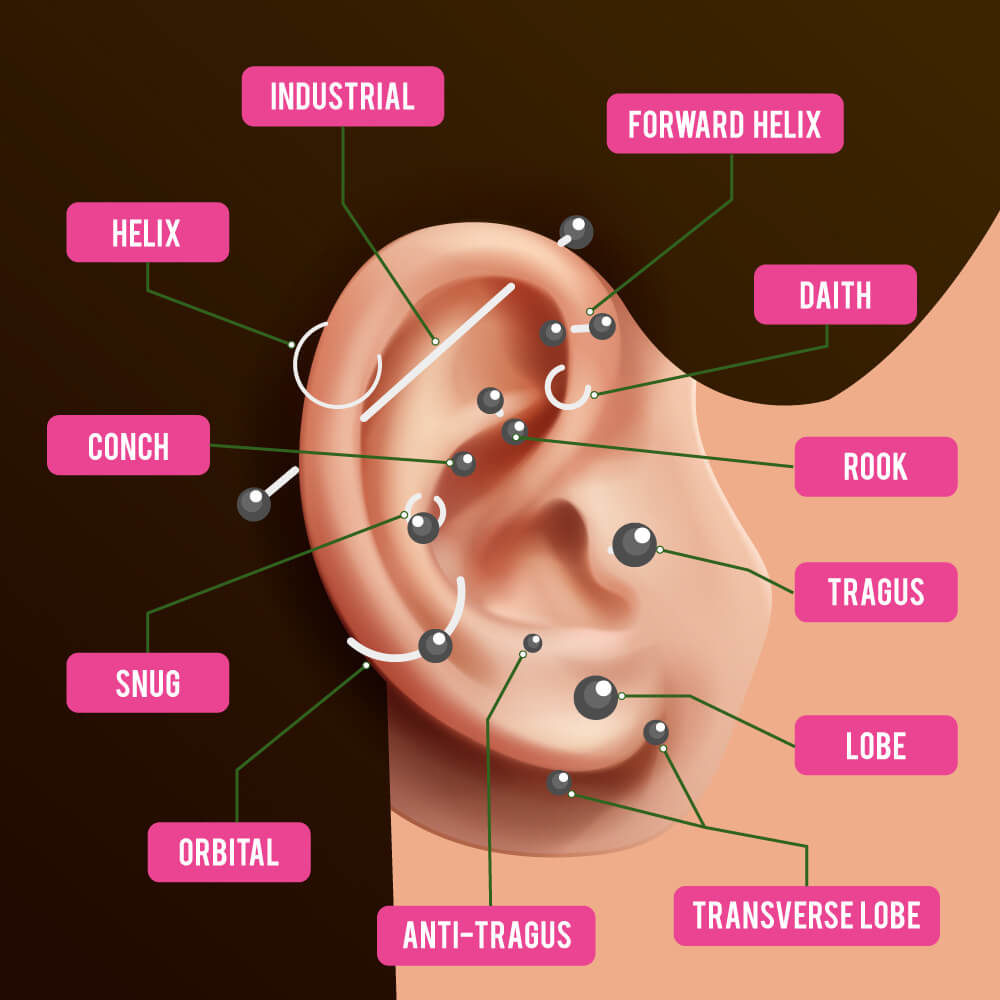
Tragus
Anatomy of the Tragus
The tragus is a small, pointed piece of cartilage that protrudes from the external ear. Located right in front of the ear canal, it serves as a natural protection and helps to funnel sound waves into the ear. The tragus is easily identifiable by its unique shape and can vary in size and thickness from person to person.
Tragus Piercing Process
Getting a tragus piercing involves the careful insertion of a small gauge needle through the tragus. Before the procedure, the piercing artist will clean the area to ensure proper hygiene. You will be asked to sit or lie down comfortably while the piercing is being performed. The piercer will mark the spot where the needle will go through and then use a sterilized needle to create the piercing. Afterward, a piece of jewelry, such as a labret stud or a small hoop, is inserted into the freshly pierced tragus.
Healing and Aftercare
After getting a tragus piercing, it is crucial to follow proper aftercare to ensure a smooth healing process. The healing time for a tragus piercing can range from 4 to 8 weeks, depending on individual factors. During this period, it is important to clean the piercing twice a day using a saline solution or a piercing aftercare spray. Avoid touching the piercing with dirty hands or rotating the jewelry excessively, as it can introduce bacteria and delay the healing process. Be gentle when washing your hair or sleeping on the pierced side to avoid irritation.
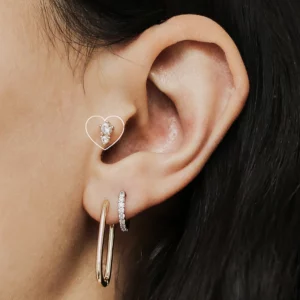
Rook
Anatomy of the Rook
The rook is another type of ear piercing that involves the cartilage fold located on the antihelical ridge, just above the tragus. It is a unique and stylish piercing that adds a touch of edginess to the ear. The rook piercing creates a beautiful visual effect as it sits nestled inside the ear, making it an attractive choice for those looking for a more discreet yet fashionable piercing.
Rook Piercing Process
Similar to other cartilage piercings, a rook piercing involves the use of a sterile needle to create a small hole. The piercer will carefully clean the area, mark the entry and exit points, and guide the needle through the fold of cartilage. Once the needle is in place, a piece of jewelry, typically a curved barbell or a captive bead ring, is inserted and securely fastened.
Healing and Aftercare
The healing process for a rook piercing can take anywhere from 6 to 12 months. During this time, it is important to maintain proper aftercare practices. Cleaning the piercing twice a day with a saline solution or piercing aftercare spray can help prevent infection and promote healing. Avoid touching or playing with the jewelry and be cautious while brushing your hair or wearing headphones to prevent irritation. It is essential to follow the aftercare instructions provided by your piercer and seek professional advice if you experience any complications.
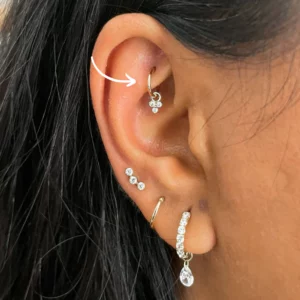
Helix
Anatomy of the Helix
The helix piercing is one of the most popular ear piercings, which involves the upper curved portion of the ear known as the helix. This area offers a wide range of possibilities for decoration and customization, making it a versatile choice for self-expression. The helix can be pierced at various locations, including the outer edge and the inner rim of the ear, allowing for individual creativity and unique combinations of jewelry.
Helix Piercing Process
To achieve a helix piercing, the piercer will first clean the area thoroughly to prevent infection. Afterward, they will mark the desired location for the piercing. Using a sterilized needle, they will carefully create a hole through the helix. Following the piercing, an appropriate piece of jewelry, such as a stud, hoop, or barbell, will be inserted into the freshly pierced hole, completing the process.
Healing and Aftercare
The healing time for a helix piercing can vary, ranging from 3 to 12 months, depending on factors such as individual health and aftercare practices. During the healing process, it is important to keep the piercing clean by using a saline solution or a piercing aftercare spray. Avoid sleeping on the pierced side and be cautious when styling your hair or wearing hats to prevent snagging or irritation. If you experience excessive pain, swelling, or signs of infection, consult a professional piercer or healthcare provider for guidance.
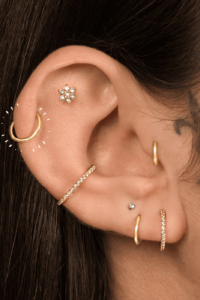
Popular Ear Piercing Trends
Tragus Piercing
Tragus piercings have gained immense popularity in recent years due to their unique placement and versatility. This piercing offers a subtle yet stylish statement, complementing various ear jewelry styles. Whether you opt for a dainty stud or an eye-catching hoop, tragus piercings allow you to express your individuality and enhance your overall look.
Rook Piercing
Rook piercings are becoming increasingly popular as they add an element of sophistication and uniqueness to any ear. With a placement that sits tucked away, the rook piercing offers an ideal canvas for displaying intricate and decorative jewelry. This piercing is a great choice for those who desire a more discreet yet captivating addition to their ear piercings.
Helix Piercing
The helix piercing has become a staple in the world of ear piercings, loved for its versatility and ability to express personal style. Whether you choose to adorn your helix with a row of simple studs or create an intricate combination of hoops, this piercing lends itself to endless possibilities. The helix piercing has attracted attention from individuals of all ages, thanks to its ability to effortlessly elevate any ear jewelry combination.
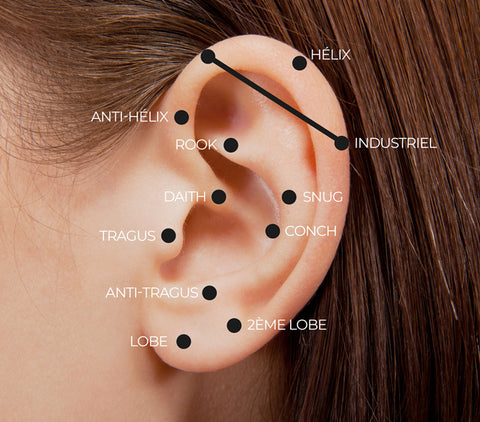
Choosing the Right Ear Piercing
Factors to Consider
When deciding on the right ear piercing for you, there are several factors to consider. Firstly, consider the anatomy of your ear and the specific placement options available. Each ear may have different features that can affect the suitability of certain piercings. It is also important to think about your lifestyle and the level of commitment you are willing to make to the aftercare process. Other factors to consider include pain tolerance, desired aesthetic, and the ability to showcase different jewelry styles.
Personal Style and Preferences
Your personal style and preferences play a significant role in choosing the right ear piercing. Consider the overall look you want to achieve and how the piercing will fit into your existing aesthetic. Some may prefer a more minimalist and discreet approach, while others may desire bold, statement piercings. Take into account your wardrobe, hairstyles, and the jewelry you are drawn to when considering the right ear piercing for you.
Placement and Suitability
The placement of an ear piercing can greatly impact its overall appearance and comfort. Different ear piercings have specific areas where they are traditionally placed, while others offer more flexibility. Consider the shape of your ear, the visibility of the piercing, and how it will work with your existing piercings, if any. Additionally, take into account any potential conflicts with glasses or headphones that may affect the suitability of certain piercings.
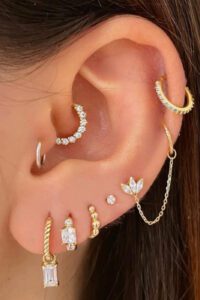
Potential Risks and Complications
Infection
One of the potential risks associated with ear piercings is infection. The punctured skin provides a pathway for bacteria and other microorganisms to enter the body. To minimize the risk of infection, it is crucial to follow proper aftercare practices, such as cleaning the piercing regularly and avoiding exposure to dirty environments. If you notice any signs of infection, such as redness, swelling, or pus, seek medical advice promptly.
Allergic Reactions
Some individuals may experience allergic reactions to certain types of jewelry, such as nickel-based metals. These reactions can manifest as redness, itching, or skin irritation around the piercing site. To minimize the risk of allergic reactions, opt for jewelry made from hypoallergenic materials, such as titanium or surgical steel. If you suspect an allergic reaction, consult with a professional piercer or healthcare provider for appropriate recommendations.
Keloids and Hypertrophic Scars
Keloids and hypertrophic scars are raised, thickened areas of scar tissue that can develop around piercings. Certain individuals may be more prone to these types of scars due to genetic factors or skin type. To reduce the risk of keloid formation, it is important to follow proper aftercare and avoid unnecessary trauma to the piercing. If you notice abnormal scarring, consult a professional piercer or healthcare provider for guidance.
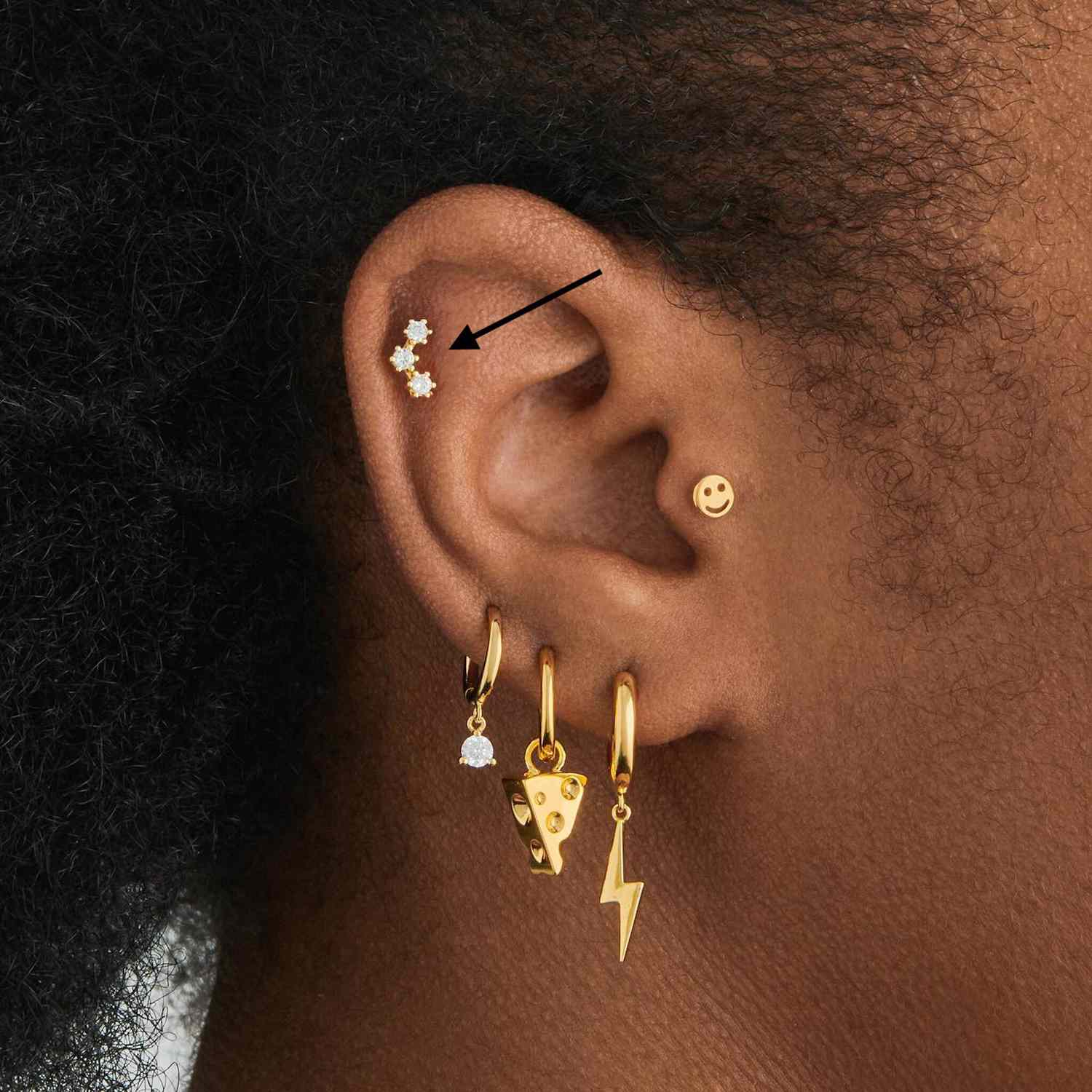
Professional Piercing vs. DIY Piercing
Benefits of Professional Piercing
Opting for professional piercing offers numerous benefits and advantages compared to DIY piercing. Professional piercers have extensive knowledge and experience in performing safe and precise procedures. They are trained in sterilization techniques and follow strict hygiene protocols, minimizing the risk of infection. Professional piercers can provide valuable aftercare guidance and advice, ensuring a smooth healing process. Additionally, they have access to a wide range of high-quality jewelry options, allowing for customization and personalization.
Risks of DIY Piercing
DIY piercing poses various risks and should be avoided whenever possible. Lack of proper knowledge, skill, and sterile equipment can increase the risk of infection, scarring, and other complications. DIY piercing often involves using non-sterile instruments, which can introduce harmful bacteria and increase the likelihood of infection. Without proper aftercare guidance, DIY piercings may not heal properly, leading to prolonged healing times or the need for medical intervention.
Importance of Sterility
The importance of sterility cannot be overstated when it comes to ear piercings. Sterile equipment and techniques are essential to minimize the risk of infection and complications. Professional piercers use autoclaves, which are medical-grade sterilization devices, to ensure all instruments are free from harmful microorganisms. Sterility plays a crucial role in the success of a piercing, as it promotes safe healing and prevents the spread of infectious pathogens.
Jewelry Options for Ear Piercings
Studs
Studs are a classic and versatile jewelry option for ear piercings. They come in various designs, ranging from simple and understated to intricate and decorative. Studs are typically secured with a backing, making them a secure choice for everyday wear. They are suitable for various ear piercings, including tragus, rook, and helix, and come in a wide range of materials, colors, and gemstone options to suit individual preferences.
Hoops and Rings
Hoops and rings are popular choices for those looking to make a statement with their ear piercings. They offer a unique and edgy look, adding a touch of individuality to any ear. Hoops and rings come in different sizes, diameters, and styles, allowing for endless possibilities when it comes to personalizing your ear jewelry. They are commonly found in helix and rook piercings, but can also be worn in other ear piercings depending on the desired aesthetic.
Barbells and Curved Barbells
Barbells and curved barbells are ideal for ear piercings that require a longer piece of jewelry, such as helix and rook piercings. They offer a sleek and minimalist look, perfect for those who prefer a subtler approach to their ear jewelry. Barbells and curved barbells are available in different lengths, gauges, and finishes to accommodate various ear sizes and personal preferences. With their clean lines and understated elegance, these jewelry options can effortlessly elevate any ear piercing.
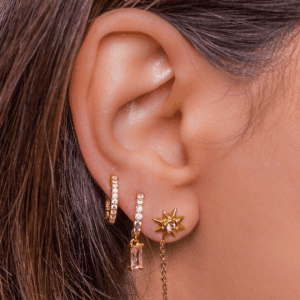
9. Ear Piercing Aftercare
Cleaning and Hygiene Practices
Proper cleaning and hygiene practices are crucial for successful healing and minimizing the risk of infection. Clean the pierced area twice a day using a saline solution or a piercing aftercare spray recommended by your piercer. Gently clean around the jewelry, ensuring that all sides are thoroughly cleansed. Avoid using harsh cleansers, alcohol, or hydrogen peroxide, as they can dry out the skin and delay the healing process.
Avoiding Irritants
During the healing process, it is important to avoid irritants that can prolong healing or lead to complications. Avoid submerging the piercing in bodies of water, such as swimming pools or hot tubs, as they may contain bacteria or chemicals that can irritate the piercing. Additionally, minimize exposure to hair products, perfumes, and lotions, as these can cause irritation and allergic reactions. Follow the aftercare instructions provided by your piercer and seek professional advice if you are uncertain about certain activities or products.
Touching and Rotating the Jewelry
While it may be tempting to touch or rotate the jewelry, it is best to avoid unnecessary contact with the piercing. Touching the piercing with unwashed hands can introduce bacteria and increase the risk of infection. Excessive rotation of the jewelry can also disrupt the healing process and cause irritation. Only touch the piercing when cleaning it and handle the jewelry with clean hands to minimize the risk of contamination.
Ear Piercing Pain and Healing Time
Pain Levels
The pain experienced during an ear piercing can vary from person to person and depends on individual pain tolerance. Generally, the pain is often described as a quick pinch or pressure sensation during the actual piercing process. Afterward, some tenderness and soreness can be expected, which usually subsides within a few days. It is important to communicate any discomfort or pain with your piercer during the procedure to ensure a comfortable experience.
Healing Time
Healing time for ear piercings can vary depending on several factors, including the type of piercing and individual healing capabilities. On average, most ear piercings take anywhere from 6 weeks to 12 months to fully heal. Cartilage piercings, such as tragus, rook, and helix, typically have longer healing times compared to lobe piercings. It is important to be patient and attentive to proper aftercare practices throughout the healing process to promote optimal healing.
Individual Variation
It is essential to remember that everyone’s body is unique, and individual variation in the healing process is normal. Factors such as age, overall health, and lifestyle choices can affect how quickly an ear piercing heals. Some individuals may experience faster healing times, while others may require more time and attention. If you have any concerns or questions about the healing progress of your ear piercing, consult with a professional piercer or healthcare provider for guidance and reassurance.
In conclusion, ear piercings offer a myriad of possibilities for self-expression and personal style. Understanding the anatomy, processes, aftercare, and risks associated with different ear piercings is crucial for making informed decisions. Whether you choose a tragus, rook, or helix piercing, always prioritize your safety and adhere to professional aftercare recommendations. With proper care and attention, your ear piercing can become a beautiful and enduring part of your personal journey of self-expression.
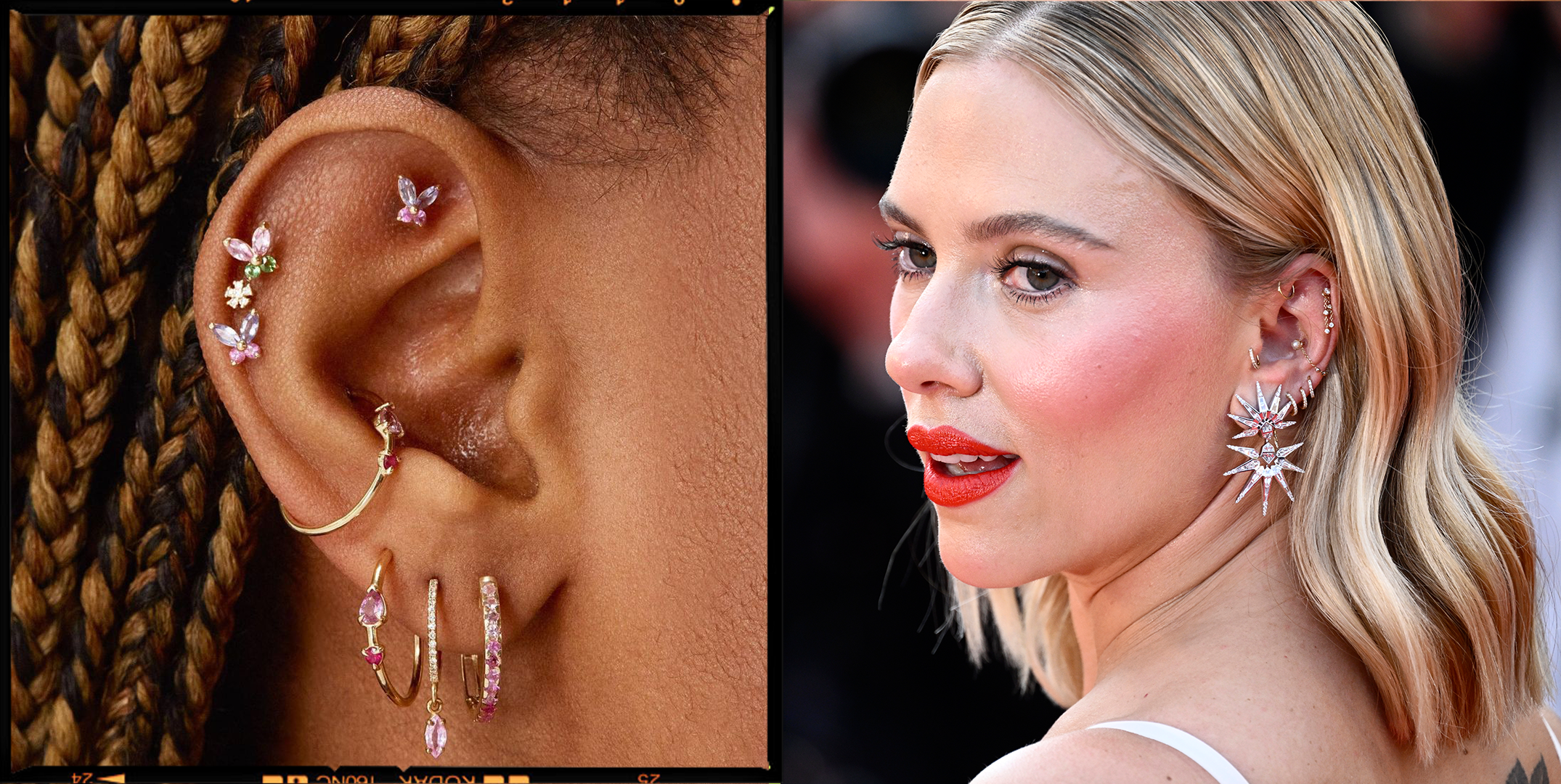
The 16 Types of Ear Piercings: Choosing Based on Pain and Placement(Opens in a new browser tab)
Stylish.ae’s Ultimate Guide To Ear Piercings: From Lobe To Cartilage(Opens in a new browser tab)
10 Things You Need to Know About Tragus Piercings(Opens in a new browser tab)

